Whiteboards naturally joined the group as well, and today we have digital whiteboard apps like Miro. Using graphics on a blank canvas, enable real-time brainstorming and team collaboration.
But is Miro being difficult for you? Or are you only researching Miro options as you test the market?
In any case, you’ll discover the solution today.
We’ll talk about the top 15 Miro alternatives in this article.
Let’s go.
What exactly is Miro Board?
A cloud-based platform for collaboration and whiteboarding called Miro Board was created to improve company cooperation. It enables groups to design virtual rooms for collaboration, planning, and project management.
It enables teams to swiftly generate graphics like flowcharts, mind maps, and sticky notes because of its user-friendly drag-and-drop interface. In order for everyone to work together at the same location, it also facilitates real-time collaboration with distant teams.
As a consequence, organizations may enhance team member cooperation and communication. A large collection of themes, icons, and connections with other well-known apps, like Slack, Google Drive, Dropbox, Jira, Trello, and more, are also available through Miro Board.
These capabilities enable firms to improve productivity by streamlining workflow procedures.
How does the Miro Board operate?
With the help of the online collaboration tool Miro Board, companies can work together in real time from anywhere. It makes it simple and effective for teams to collaborate on projects. Teams may brainstorm, debate concepts, and produce visualizations using Miro Board to keep everyone on the same page. Miro Board offers a virtual workspace where teams can rapidly get up and running because of its user-friendly design.
Miro Board functions by giving users a shared online workspace where they may work together on projects. It offers a number of features that are intended to improve cooperation, such as the ability to use a whiteboard, drag-and-drop picture uploading, text chat functionality, and more.
In order to allow customers to maintain their workflow organization in one location, the platform also enables connectivity with well-known programs like Slack and Google Drive. Miro Board’s user-friendly interface makes it simple for companies of all sizes to rapidly get up and running with the platform.
There are several possibilities on the market in 2023 for companies seeking Miro Board substitutes. Depending on your demands and budget, there are several solutions accessible, ranging from free tools like Google Jamboard to premium platforms like Conceptboard or Stormboard. All of these alternatives to Miro Board include features that are comparable, although they may have different price structures or integrations.
What features does the Miro Board offer?
A variety of features and capabilities are available to organizations through the cloud-based collaboration platform Miro Board, which enables them to collaborate more effectively.
Regardless of their geographical location, this technology enables teams to interact in real-time. Users may make digital whiteboards using Miro Board and distribute them to other team members. Users may add photographs, videos, documents, and sticky notes to the boards to keep track of chores and ideas.
Real-time chat is also supported, allowing distant teams to communicate with one another. For enhanced collaboration, Miro Board also provides a number of connectors with well-known programs like Trello and Jira. In conclusion, Miro Board enables corporate teams to work together on projects in a productive and structured way.
Why search for an alternative to Miro?
An online whiteboard tool called Miro is used for visual collaboration.
The software offers a variety of tools for effective brainstorming sessions and is ideal for distant work. For instance, it enables you to draw simple wireframes without any prior design knowledge, something you cannot accomplish with a traditional whiteboard.
And although it seems wonderful, there are some glaring problems with Miro.
These are some of the main problems you’ll encounter with this virtual whiteboard platform and reasons why you might want to search elsewhere:
Not all platforms are supported.
Mac and Windows platforms are supported by Miro. I’m glad there’s no room for the notorious Windows vs. Mac argument!
1. Nuclino
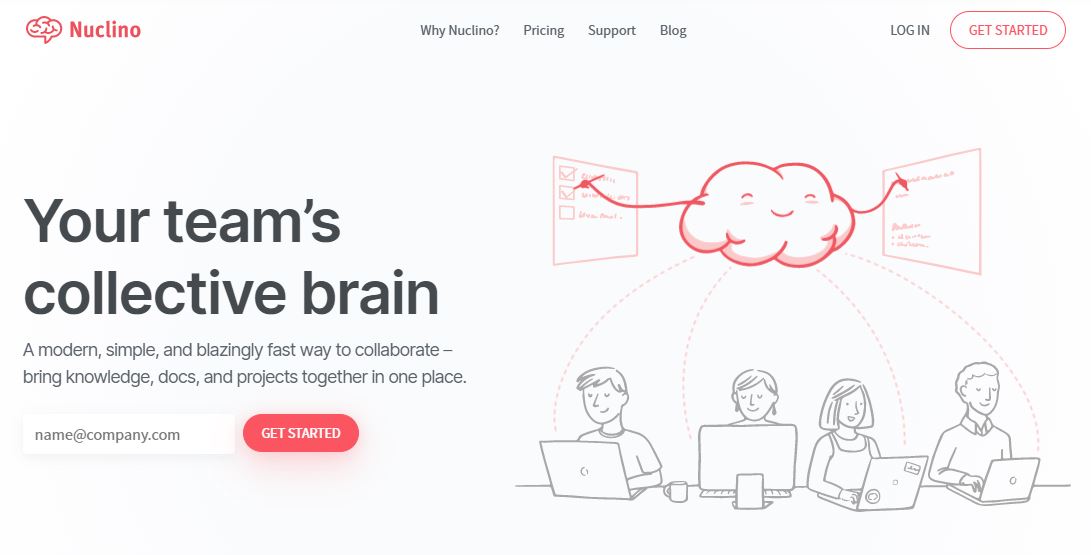
Miro may be replaced by Nuclino, a simple and lightweight replacement. It distinguishes itself with a simple, uncluttered user interface and clear navigation that reduce the learning curve and make getting started a breeze.
Several of the essential Miro features are available in Nuclino, including a Kanban board where you can drag and drop cards to see your progress. You can also maintain extra information about each card, such as due dates, assignees, labels, and more — anything that’s critical for your workflow.
In a sense, Nuclino is a combination of Miro and Google Docs. Each card on your board is a separate, lengthy document that can be worked on in real-time collaboration. With the help of notes, to-do lists, embedded files, and more, you can effortlessly organize and document all of your tasks in one location.
In Nuclino, you may communicate feedback immediately while maintaining the context of each decision.
The board is not the only method you may use to organize your data with Nuclino. If the Kanban method is not your thing, you may arrange your projects in a nested list, table, or mind map-style graph. Because of its versatility, it is excellent for organizing tasks and projects as well as collecting notes, producing internal documentation, and developing a team wiki or internal knowledge base.
2. ClickUp
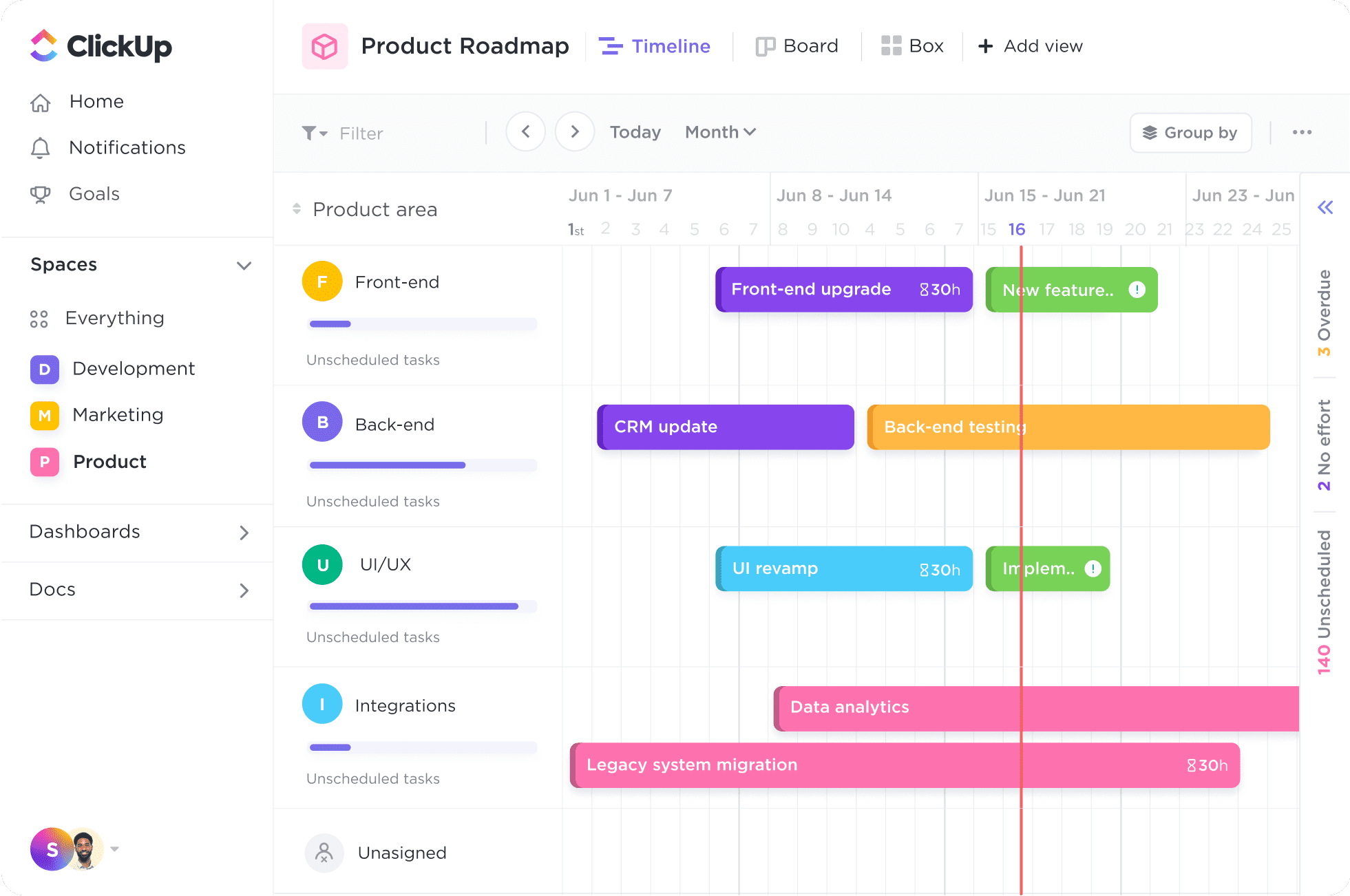
Although ClickUp is at the top of our list, there are many more excellent arguments and client success stories that support their decision to leave. ClickUp is an all-in-one productivity tool where teams can plan, organize, and communicate on work using tasks, documents, chat, goals, whiteboards, and more!
More than 15 customizable views are offered by ClickUp, with at least 10 of them included in the free lifetime plan. And if you find it difficult to leave Miro straightforward, user-friendly board interface, you’re in luck.
Projects move as quickly as you do with the ClickUp Board View because you can drag and drop practically anything. Take it a step further by personalizing or organizing jobs by fields that make the most sense to you and your team.
Want more? For people who want to examine their projects and assign tasks in a GTD-style to-do list, the ClickUp List view is ideal.
3. Wrike
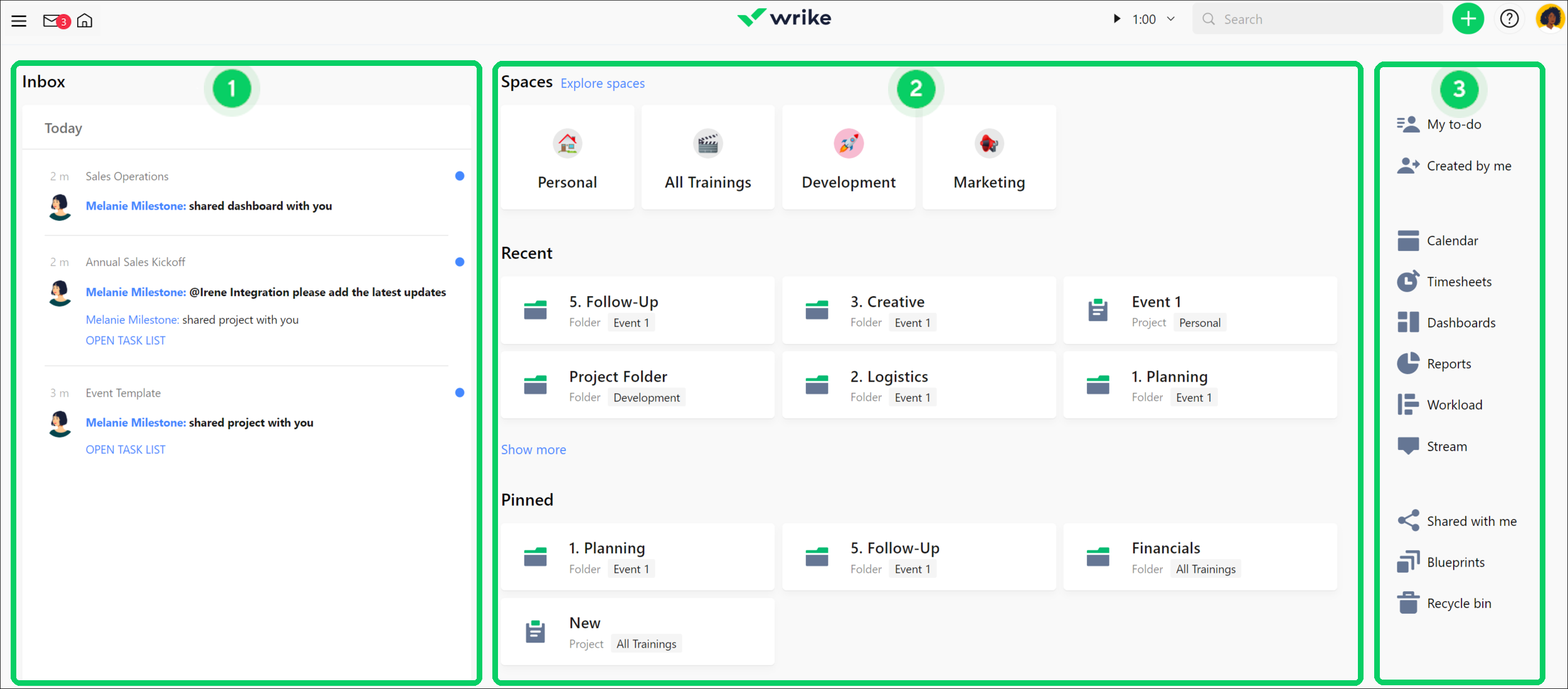
Wrike is an award-winning, easy-to-use project management software used by 20,000+ enterprises globally. The tool is designed for teams with anywhere from five to an unlimited number of team members. Wrike contains Kanban board functionality and is extremely adjustable, allowing users to design processes, dashboards, reports, request forms, and more.
Users may select how to display their priorities using Wrike’s straightforward interface, which lets them move between configurable, shared Kanban boards, one-click Gantt charts, and conventional workload views. Task lists, subtasks, calendars, shared workflows, file sharing, and real-time collaboration are further features of Wrike.
Wrike provides a user-friendly, straightforward UI and navigation with clear areas, folders, and tasks. Users may flip between the home screen and timesheets, dashboards, calendars, reports, and the notification stream.
Wrike provides more than 400 pre-built native connectors, including connections to the most well-liked file management programs from Microsoft, Google, and Dropbox, as well as sales and marketing platforms from Marketo and Salesforce.
The cost of Wrike starts at $9.80 per user per month. There are four distinct price ranges, including a free edition and plans that let you invite cost-free outside collaborators to a paying account.
4. Asana

Asana is a project and task management application that makes team cooperation and communication a breeze. With Asana, you can assign tasks, track progress, and conduct conversations all in one location. Asana is a quick, responsive, beautiful-looking, and feature-rich application.
When a work is assigned to you or if a member of your team makes modifications to the task or project, you may exchange notes and attachments, follow and “like” tasks, set due dates, and receive email notifications.
The nicest aspect of Asana is that there is no storage cap, and it is simple to add files up to 100MB in size to tasks. Asana increases your productivity and enables you to manage all of your tasks from a single application thanks to its many third-party integrations, like Dropbox, Hipchat, Zendesk, Jira, and many others.
Asana offers list view, calendar view, and file view options for your tasks and projects in addition to the Kanban-style Miro interface. It’s a fun, straightforward piece of software that gets the job done well.
5. nTask
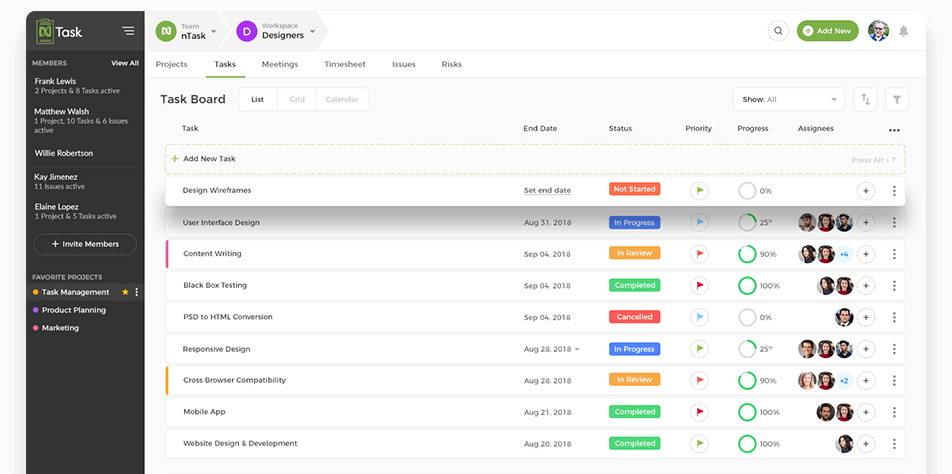
Another amazing alternative worth checking out is nTask. Its comprehensive feature set encompasses everything offered.
nTask offers a range of various data visualization choices and gives customers a clear picture of all their projects and activities. You can quickly arrange and move through all of your everyday duties using the drag-and-drop interface.
When it comes to task and project management software, nTask is one of the most well-liked solutions and may be an excellent solution for both small businesses and large corporations.
6. ProofHub
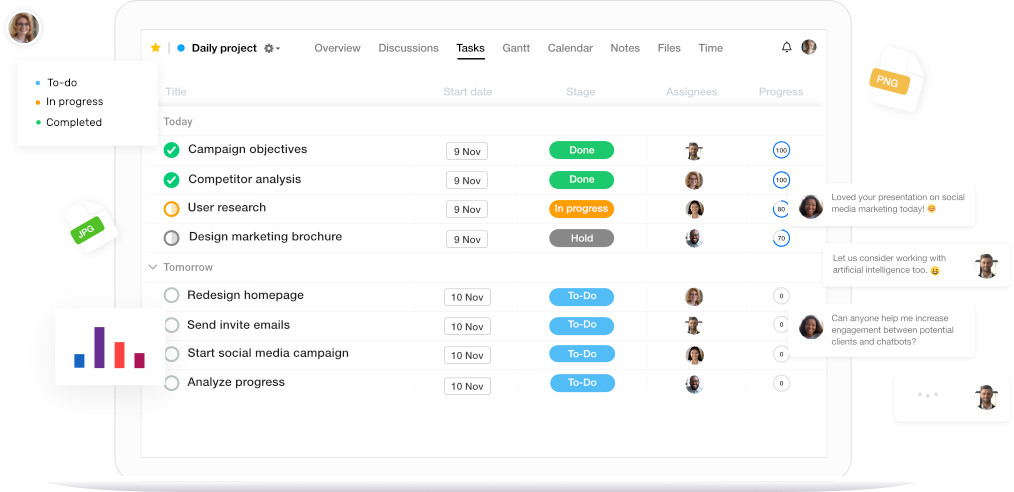
Another excellent Miro substitute is ProofHub. With numerous useful tools, project managers will have no issue managing their projects properly. The program does not, however, have any functionality for managing intricate projects. For instance, Proofhub lacks a number of automation and long-term project planning tools. Hence, if you have intentions to grow as a small team, this project management application probably won’t be able to do so.
7. monday.com

One of the few tools that pride itself on “not being a project management tool” is Monday.com, an award-winning platform. They’ve done away with a lot of the trimmings of usual tools and concentrated on simple structures that help clear the sequence of work that has to be done.
This program can really do a lot more. Several perspectives of work are available on Monday.com, such as a list, on a map, on a Kanban board, in a spreadsheet, and others. Users may upload and attach files to cards, write comments, name colleagues, and more. Moreover, it provides a fantastic project reporting dashboard that can gather information from many boards for improved progress monitoring.
This tool’s notable features include tools for automating certain jobs and task boards that can be customized to help users manage tasks by cards, assignees, due dates, hours spent, etc. Ultimately, it’s a very adaptable tool that enables you to work in whichever methodology—kanban or otherwise—fits your project and team.
Project management software, including Slack, Google Drive, Gmail, Google Calendar, Jira, GitHub, Dropbox, Typeform, and many more, are integrated with Monday.com using Zapier.
Monday.com has a free 14-day trial, and prices start at $6 per user each month. For a maximum of two users, they provide a free plan.
8. JIRA
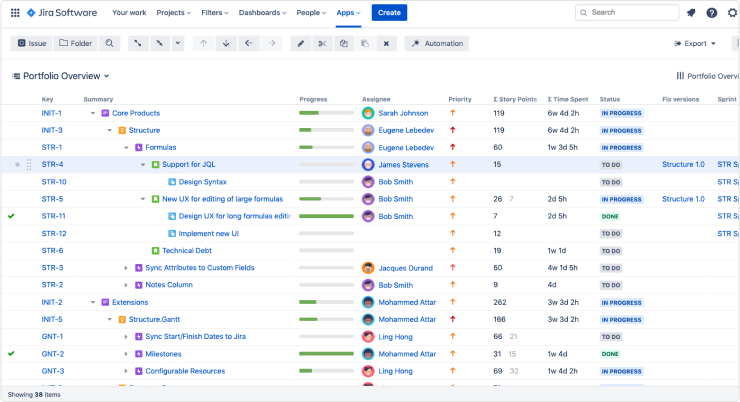
JIRA is particularly developed for development teams. It is a tool for software development that assists teams in the planning, monitoring, and release of excellent software. By creating automated reports, you may even assess the timeliness and advancement of your projects. To increase the effectiveness and performance of your team, you may assign and distribute tasks, follow each project with complete visibility, and receive real-time information.
By combining Jira with countless add-ons, such as Hipchat, Zephyr, Bitbucket, Confluence, and many more, you may improve it. For your software engineers to stay in sync while you’re on the move, JIRA also offers mobile apps.
9. Workzone
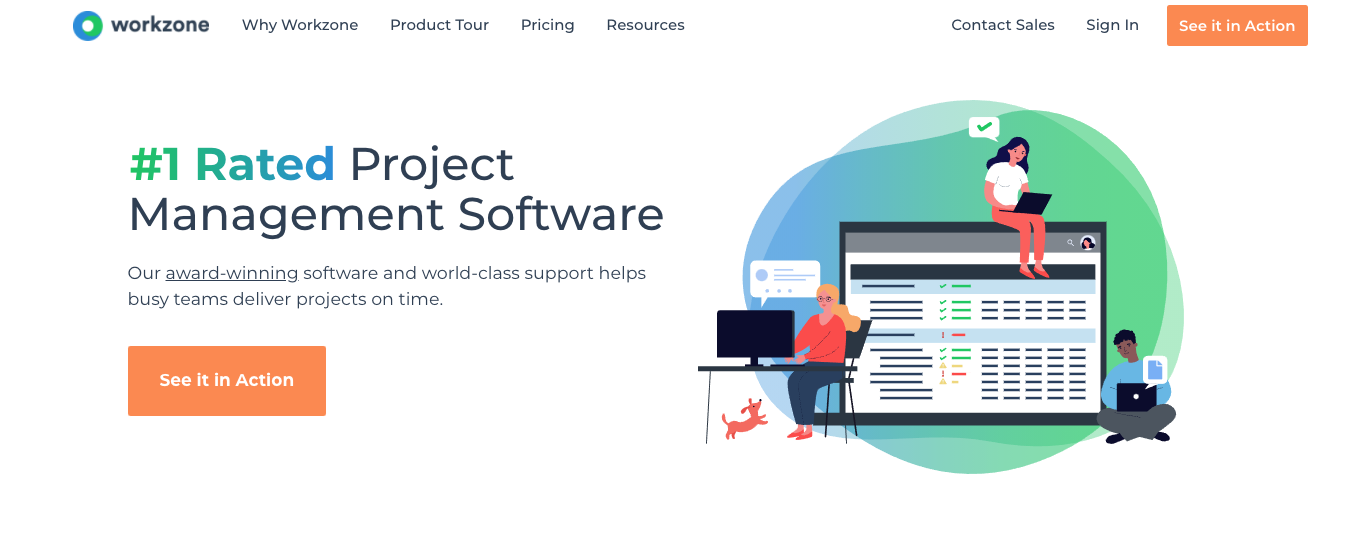
Workzone is a basic project management tool with a user-friendly UI. It’s one of the top real-time collaboration solutions, just like Zenkit, and will help your team collaborate effectively. As the app doesn’t provide a free trial plan, entrepreneurs and small companies must avoid this area.
10. Airtable
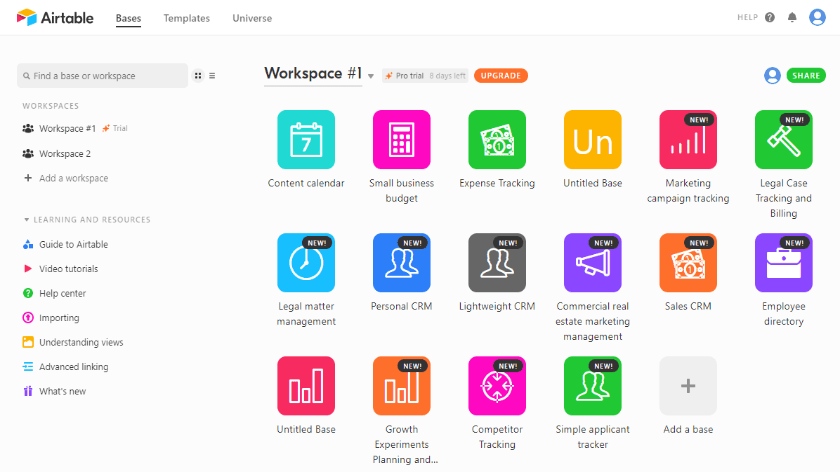
Airtable can adapt to the specific requirements of any team. If you appreciate searching and filtering, then you’ll find Airtable a great database for project management.
Do you enjoy using spreadsheets for project management but occasionally feel constrained by your inability to go beyond text in cells? Airtable is simply the tool you need. With its vibrant user interfaces and simple mobile and desktop apps, Airtable makes the sometimes tedious chore of adding, organizing, and collaborating on data much more natural.
The best thing is that Airtable gives you the option to transform your data into a grid, or gallery, so you are not forced to continue seeing your work in spreadsheet form. The extremely versatile data fields in Airtable allow you to insert any kind of material, including long text notes, checkboxes, attachments, and connections to records in other databases.
Slack, Gmail, Dropbox, Google Drive, Zendesk, and even social networking sites like Facebook, Twitter, and Instagram may all be linked with Airtable.
11. Avaza
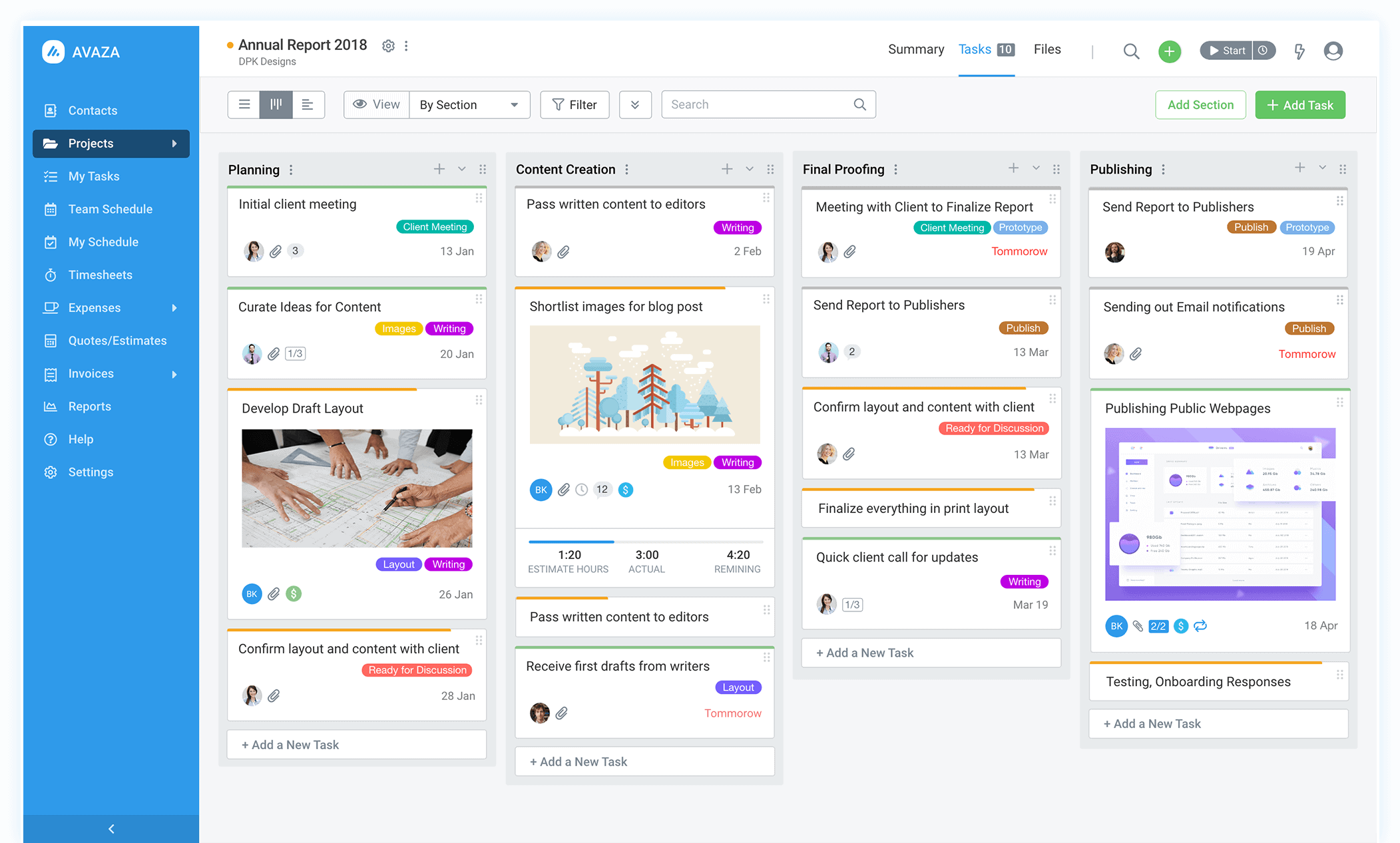
Avaza is a project management application with some accounting software bells and whistles. Users can work together, keep track of the time spent on tasks or projects, create expense reports and timesheets, send clients bills, and even be paid directly through the tool.
With email-enabled conversations and notifications, Avaza makes cooperation simple. For tasks that you create, it also offers the option to switch between Kanban, Gantt, and list views. It even lets you turn emails into tasks, keep track of how often tasks are completed, how much time is spent on each work, and much more. You may integrate files into Avana from your Dropbox or Google Drive to store all your work in one area to minimize duplication and confusion.
For independent contractors or small firms, Avaza is extremely helpful. It allows you to share your project board with your customers, send them bids, and exchange project reports. The clients or customers may then keep track of the time spent, get invoices via Paypal, Visa, Mastercard, etc., and pay them.
A single user may use Avaza for free and has access to five projects, ten clients, five invoices, and 100MB of storage space per month. The pro plan begins at $9.95/month.
12. Todoist
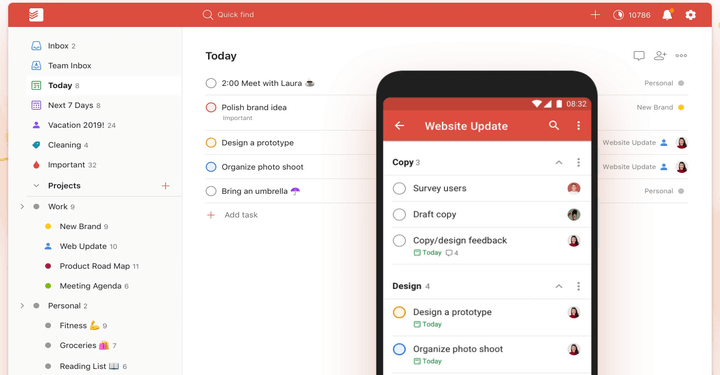
Todoist has long promoted itself as a lightweight personal task management solution that enables users to arrange their chores into straightforward to-do lists. Things changed in 2020, when Todoist firmly established itself as a Miro competitor by introducing a brand-new Kanban board view.
Todoist is obviously easier than Miro and lacks many of its complex capabilities. Depending on your process, this can be viewed as both a strength and a weakness. Compared to Trello, Todoist’s user interface is more streamlined, contemporary, and uncluttered. It has a small learning curve and makes it as easy as possible to get started. Todoist also has fewer customization possibilities and is less adaptable than Trello. It’s up to you to decide if it’s the best trade-off.
The premium membership plan of Todoist is also substantially more economical, making it a more accessible alternative for projects with restricted finances.
13. Hive

If you’re moving on from Miro because you’re outgrowing it and are wanting something with greater capability, then you’ll want to check out Hive. Hive treads the delicate balance between customization and usability, so you can not only have access to a full array of tools, reports, and functionalities, but you can also get set up and get started with very little downtime.
Miro is obviously weak in the customization sector and does not allow custom charts, fields, or reports, whereas Hive offers all of them. And whereas Miro is confined to only Kanban layouts, Hive allows you to see tasks in Kanban boards or in 5 more project views, including Gantt, Table, and Calendar views, so that you may arrange activities in the way that best matches your workflow.
It’s also important to keep in mind the emphasis on integrations. Hive offers native connections with over 1,000 apps and programs, including Salesforce and Gmail. You may choose which tools you want to combine and which you’d like to keep separate because each integration is based on an app-by-app basis.
Hive’s simple, adaptable user interface also makes it a perfect option for teams of any size and experience. Smaller teams will adore Hive Chat and its emphasis on cooperation, but bigger teams will appreciate how easy it is for the manager to set and show particular assignments, making communication clear and easy to follow at all times. In addition to a premium Hive Teams membership, which begins at $12 per month, Hive also provides a free lifetime option.
14. Height
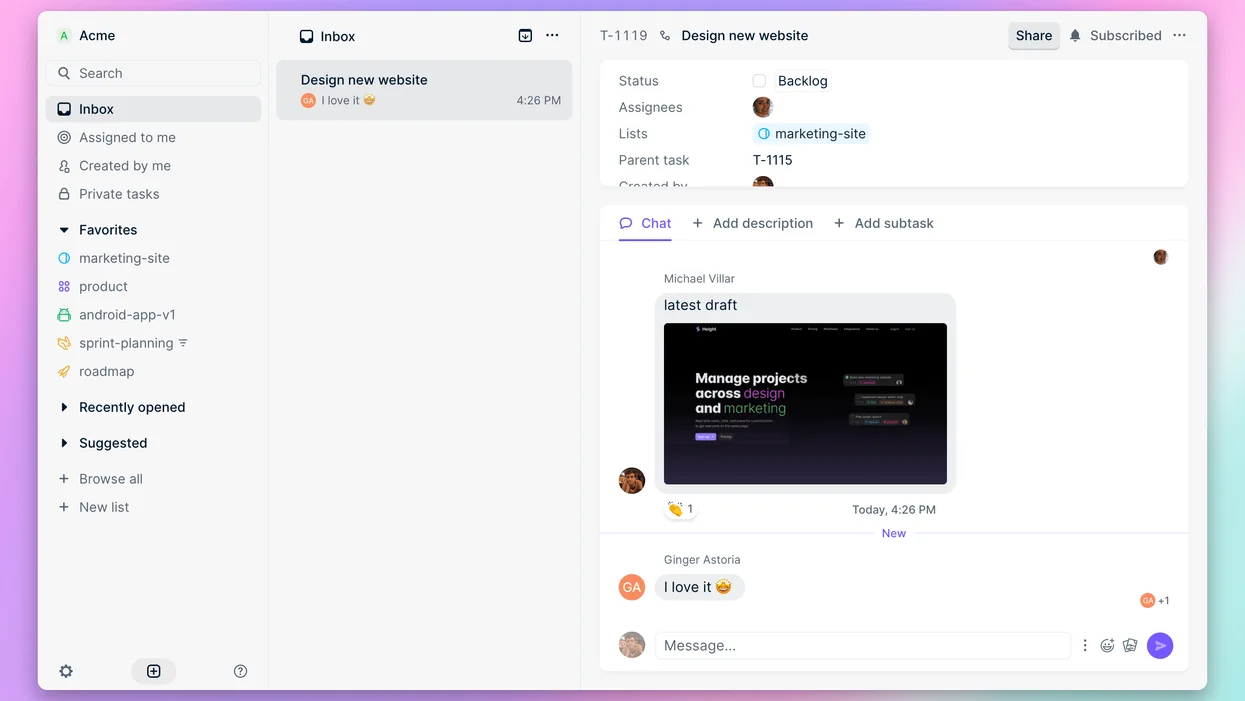
Height is the all-in-one project management platform that can be used as a Miro replacement because of its limitless guest accounts and featured visualizations like spreadsheets (tables), Kanban, calendars, and Gantt charts—anything that is only available with Trello’s premium membership.
Kanban boards, in particular, are excellent for displaying the current status of your team’s work in one convenient location. You may quickly add new tasks from your board and drag and drop multiple jobs from one column to another. They also give you the option of deciding how long completed tasks should remain on your board, so you may leave them on for the whole of the workweek before they disappear on their own at the beginning of the next week.
Since Height has a conversation for each assignment, you may continue to collaborate in real-time. This chat feature makes sure that all discussions concerning work take place in context, are searchable, and only inform those who need to know.
Its extensive portfolio includes macOS and Windows apps, SOC 2 Type II compliance for data protection and a command menu where you can personalize keyboard shortcuts for practically anything you can imagine.
Via Zapier, integrations are available for Notion, Slack, Discord, GitHub, GitLab, Sentry, Zendesk, Figma, Slab, Fivetran, and many more. With a free 30-day trial, Height’s price starts at $6.99 per user each month. Last but not least, all paid plans provide free guest accounts.
15. Basecamp
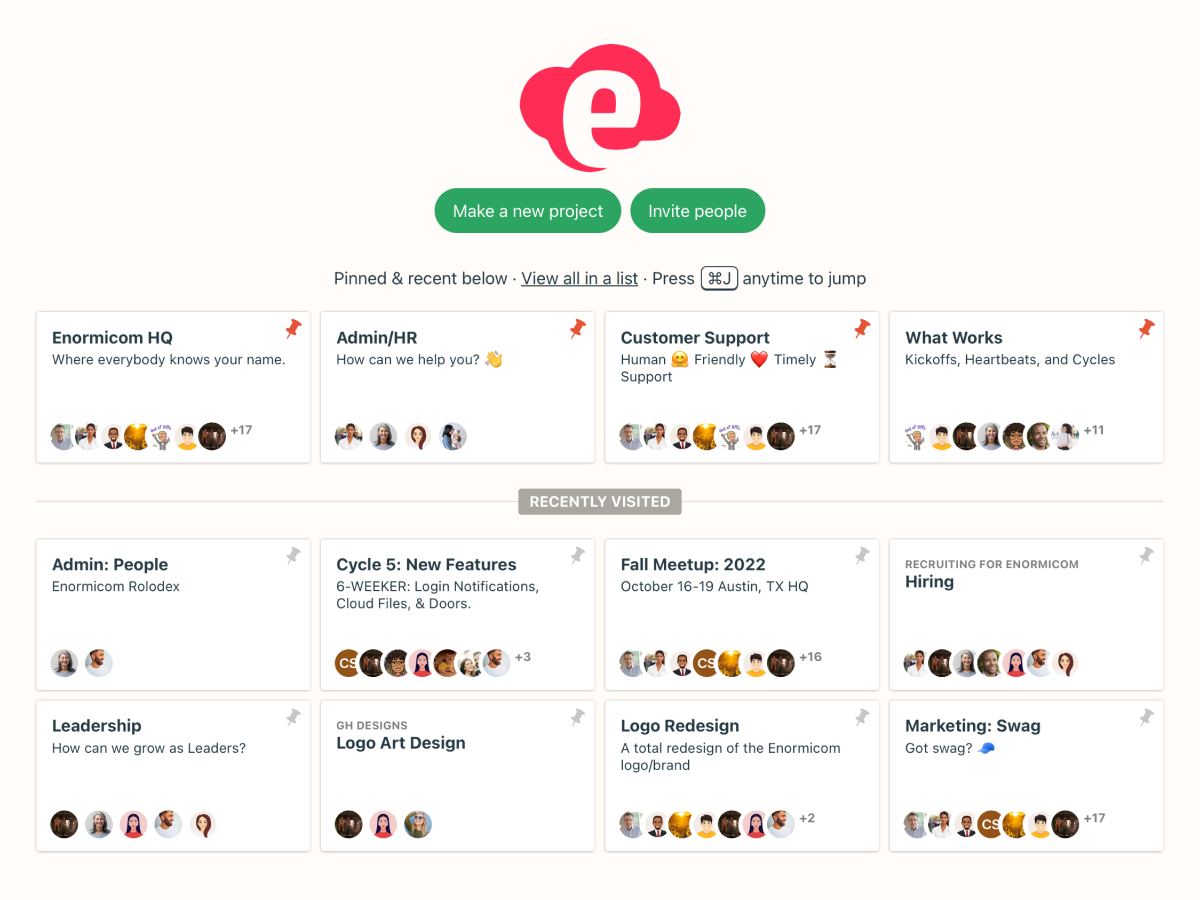
Basecamp, one of the first productivity and remote collaboration applications on the market, was introduced in 2004.
To-do lists, calendars, chat, and file management are all combined in Basecamp, allowing you to manage complete projects in one location rather than having your work dispersed over many apps and tabs. It features a reasonably intuitive UI and has a flat learning curve for such a feature-packed tool.
The program notably shines as a platform for managing virtual teams. The Basecamp team, one of the forerunners of remote work, applied their own lessons learned and experiences into the creation of their product. It’s also a terrific tool for communicating with external partners and clients.
A notable characteristic of Basecamp is its pricing approach. In contrast to most of the other products on our list, Basecamp charges a fixed monthly fee of $299 regardless of how many people you add. This makes it a highly affordable choice for big teams that are expanding quickly.

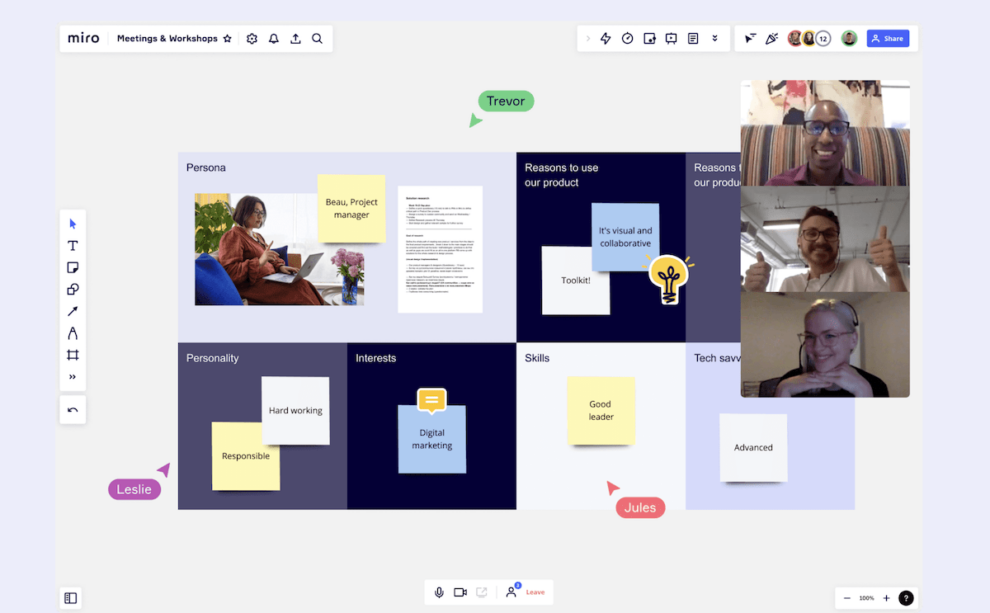








Add Comment